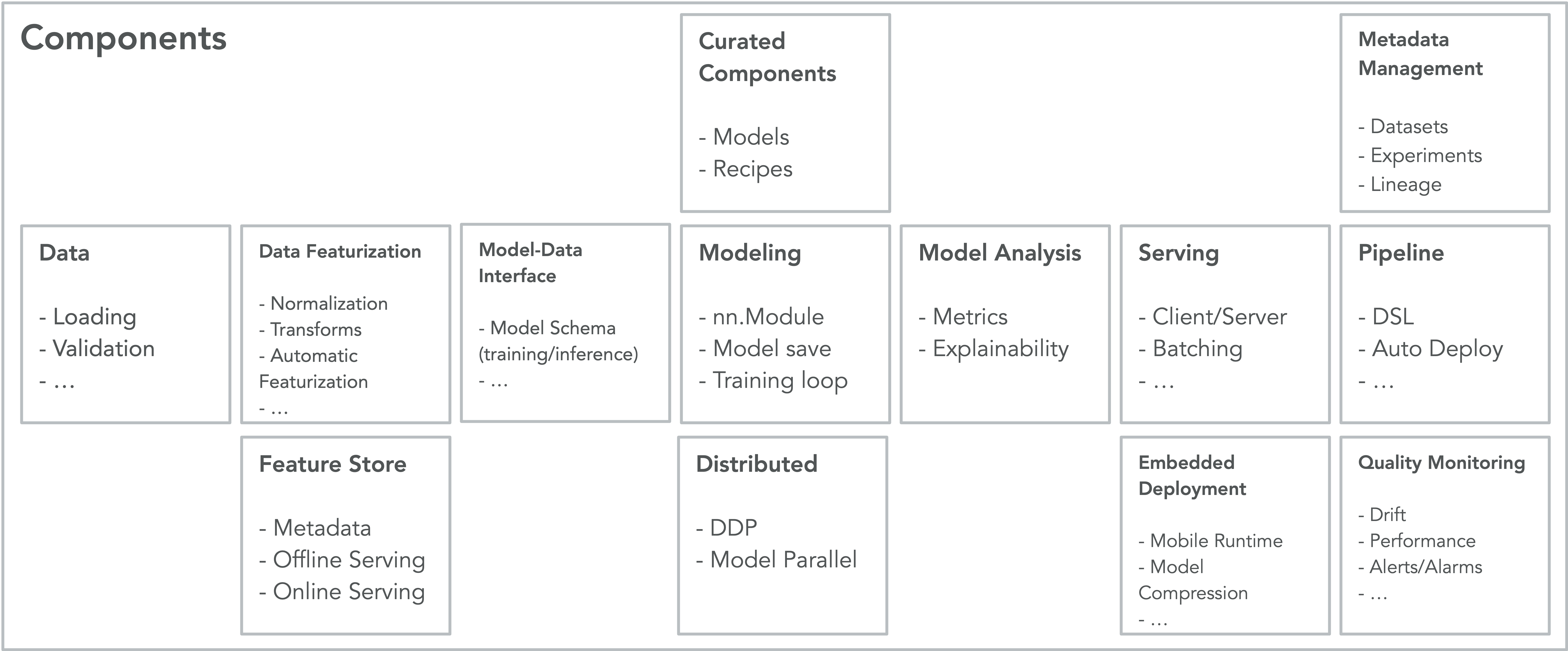概述¶

注意
上图仅用于说明目的。并非所有框当前都开箱即用。
此模块包含一系列内置 TorchX 组件。目录结构按组件类别组织。组件只是模板化的应用程序规范。可以将其视为不同类型作业定义的工厂方法。在此模块中返回 specs.AppDef 的函数是我们所说的组件。
您可以在 torchx.components 模块或我们的 文档页面 上浏览组件库。
使用内置组件¶
找到内置组件后,您可以:
将组件作为作业运行
在工作流(管道)的上下文中使用组件
在这两种情况下,组件都将作为作业运行,区别在于作业将直接在调度程序上作为独立作业运行,或作为具有上游和/或下游依赖项的工作流中的一个“阶段”。
注意
根据组件的语义,作业可以是单节点的或分布式的。例如,如果组件具有单个角色,其中 role.num_replicas == 1,那么作业就是单节点作业。如果组件具有多个角色,或者如果任何角色的 num_replicas > 1,那么作业就是多节点分布式作业。
不确定是否应该将组件作为作业或管道阶段运行?使用此经验法则:
刚开始?通过将其作为作业运行来熟悉组件
需要作业依赖项?将组件作为管道阶段运行
不需要作业依赖项?将组件作为作业运行
验证¶
要验证是否已正确定义组件,您可以:
(最简单的方法)使用 cli 对组件的
--help进行试运行:torchx run --dryrun ~/component.py:train --help使用组件 linter(请参阅 dist_test.py 作为示例)
作为作业运行¶
您可以使用 torchx cli 或以编程方式使用 torchx.runner 将组件作为作业运行。两者都是相同的,实际上 cli 在幕后使用了 runner,因此您可以根据自己的喜好进行选择。快速入门 指南将引导您完成入门的基本步骤。
以编程方式运行¶
要以编程方式运行内置组件或您自己的组件,只需将组件作为常规 Python 函数调用,并将其传递给 torchx.runner。以下是如何调用 utils.echo 内置组件的示例:
from torchx.components.utils import echo
from torchx.runner import get_runner
get_runner().run(echo(msg="hello world"), scheduler="local_cwd")
CLI 运行(内置组件)¶
从命令行运行组件时,您需要传递要调用的组件函数。对于内置组件,其形式为 {component_module}.{component_fn},其中 {component_module} 是相对于 torchx.components 的组件模块路径,而 {component_fn} 是该模块中的组件函数。因此对于 torchx.components.utils.echo,我们将删除 torchx.components 前缀,并将其运行为
$ torchx run utils.echo --msg "hello world"
有关更多信息,请参见 CLI 文档。
CLI 运行(自定义)¶
要使用 CLI 运行自定义组件,您需要使用略微不同的语法 {component_path}:{component_fn}。其中 {component_path} 是组件 Python 文件的文件路径,而 {component_fn} 是该文件中的组件函数名称。假设您的组件位于 /home/bob/component.py 中,并且组件函数名为 train(),则您将按以下方式运行它:
# option 1. use absolute path
$ torchx run /home/bob/component.py:train --help
# option 2. let the shell do the expansion
$ torchx run ~/component.py:train --help
# option 3. same but after CWD to $HOME
$ cd ~/
$ torchx run ./component.py:train --help
# option 4. files can be relative to CWD
$ cd ~/
$ torchx run component.py:train --help
注意
如果您知道 TorchX 的安装目录,则内置组件也可以以这种方式运行!
从 CLI 传递组件参数¶
由于组件只是 Python 函数,因此以编程方式使用它们非常简单。如上所述,在通过 CLI 的 run 子命令运行组件时,组件参数将作为程序参数使用双破折号 + 参数名称语法传递(例如 --param1=1 或 --param1 1)。CLI 会根据组件的文档字符串自动生成 argparse 解析器。以下是关于如何传递各种类型组件参数的摘要,假设组件定义如下:
# in comp.py
from typing import Dict, List
import torchx.specs as specs
def f(i: int, f: float, s: str, b: bool, l: List[str], d: Dict[str, str], *args) -> specs.AppDef:
"""
Example component
Args:
i: int param
f: float param
s: string param
b: bool param
l: list param
d: map param
args: varargs param
Returns: specs.AppDef
"""
pass
帮助:
torchx run comp.py:f --help基本类型 (
int,float,str):torchx run comp.py:f --i 1 --f 1.2 --s "bar"布尔值:
torchx run comp.py:f --b True(或--b False)映射:
torchx run comp.py:f --d k1=v1,k2=v2,k3=v3列表:
torchx run comp.py:f --l a,b,cVAR_ARG:
*args作为位置参数而不是参数传递,因此它们在命令末尾指定。使用--分隔符来开始 VAR_ARGS 部分。当组件和应用程序具有相同的参数或通过--help参数传递时,这很有用。以下是一些示例:**args=["arg1", "arg2", "arg3"]:torchx run comp.py:f --i 1 arg1 arg2 arg3**args=["--flag", "arg1"]:torchx run comp.py:f --i 1 --flag arg1 `` * ``*args=["--help"]:torchx run comp.py:f -- --help**args=["--i", "2"]:torchx run comp.py:f --i 1 -- --i 2
在管道中运行¶
torchx.pipelines 定义了适配器,这些适配器将 TorchX 组件转换为表示目标管道平台中管道“阶段”的对象(有关支持的管道编排器的列表,请参见 管道)。
其他资源¶
请参见
